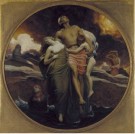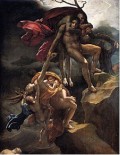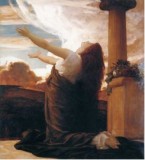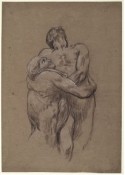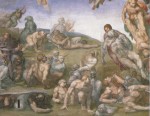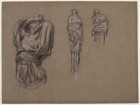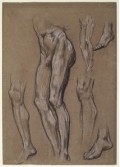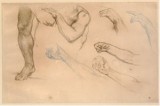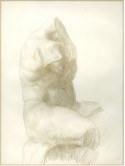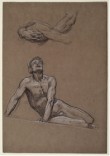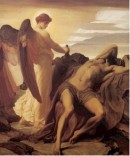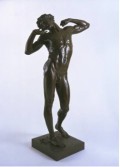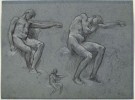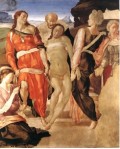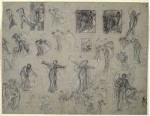The browser will either open the file, download it, or display a dialog.
Introduction
In And the Sea Gave Up the Dead Which Were In It (1877–92; fig. 1) Frederic Leighton (1830–96) gave form to the Book of Revelation's apocalyptic vision of the dead rising from their graves on the Day of Judgment. The title is quoted from Revelation 20:13; "And the sea gave up the dead which were in it; and death and hell delivered up the dead which were in them: and they were judged every man according to their works." Leighton first conceived the design in 1877 for one of the rondels in the inner dome of St. Paul's Cathedral on the theme of "Transformation." A model of the design was exhibited at the Royal Academy in 1882, and a cartoon was temporarily displayed in St. Paul's in 1884. However, due to general pressure against it, a permanent version was never installed.[1] Instead the design was only realized in 1892 as a painting for Henry Tate's new contemporary collection, its monumental size and tondo form continuing to reflect the magnitude of the original brief.[2] The project betrays the artist's aspirations to place his own name among those of the great designers of decorative schemes for Europe's cathedrals, such as Michelangelo and Raphael. It comes as no surprise, therefore, that Leighton's indebtedness to Michelangelo is nowhere more felt than in this painting.
In the first part of this paper, I argue that Leighton's treatment of the theme of resurrection in And the Sea Gave Up the Dead was influenced by the theology of his day, in particular its concern with the material resurrection of the body and the recognition of family members in the afterlife. I then argue that Leighton mobilized the Christian narrative of Divine Resurrection in order to resurrect classicism and reinstate a Michelangelesque working method. It is my contention that Leighton, working like both divine creator and Victorian archaeologist, unearthed, reassembled, and reanimated the ideal classical body in this painting. However, while the painting represents one of the artist's most strenuous applications of his academic working method, and illustrates in both execution and subject matter his neoclassical processes, Leighton ultimately proves incapable of making the once-dead figures live again—that is, anywhere other than in the gothic imagination. Doubting the success of Leighton's artistic project generally, the reviewer for The Times queried:
What it all comes to, what sentiment it is meant to excite, how we are to be affected by it. And, in spite of one's admiration, there lurks at the bottom of one's mind the suspicion that neo-classicism in art is at best an unfruitful field.[3]
Death
Leighton's painting, And the Sea Gave Up the Dead, pictures a man, a woman, and a child rising together out of the ocean, moving upward toward heaven on the Day of Judgment. It recalls Anne-Louis Girodet's Une Scène de déluge (1806; fig. 2), which Leighton would have seen at the Louvre during the years he lived in Paris, and which similarly pictures a family clinging to each other, suspended against a rocky landscape, hovering above a turbulent sea.[4] But the figures in Girodet's painting are pulled in the opposite direction; the father desperately holds onto his wife's wrist as they are dragged down into the biblical flood. In Leighton's painting the husband draws his family upward out of the ocean, epitomizing male physical and moral strength.
We can also find resonances between Leighton's conception of bodies emerging from the sea and the mythological tale of Venus's birth out of the waves and froth of the ocean, which was a popular subject for depiction by such nineteenth-century academic artists as Alexandre Cabanel and William Bouguereau.[5] In Leighton's scene, however, the female figure is compositionally displaced and it is the ideal male body which is reborn. The young boy and father hold each other tightly, their close proximity representing another kind of becoming—that of becoming a man. The lean body of the son is to become the muscled, developed, and enlivened body of the father.
The central grouping is surrounded by other figures that are also seen waking from their millennial slumbers. Kings sit up in their coffins and a man stretches his arms above his head as he frees himself from his shroud. And, in what is the most obviously gruesome representation of a rising corpse, a ghostly figure at the bottom left of the canvas, still half-submerged in his ocean-grave, begins his ascent. We see his face and hands, but the rest of his body remains bound in a death-shroud. His face is rendered in greens and blues, suggesting cold, decayed flesh. His eye sockets are shaded and the areas around his cheeks are sunken, making him appear skeletal. With an upturned head he opens his mouth as if inhaling his first gulp of air. In his painting, Leighton pictured the transformation from one state to another that is at the heart of the Resurrection narrative. The tripartite division of the picture plane into sea, rocks, and sky, mirrors the religious division of the universe into the underworld/hell, earth/purgatory, and heaven. All the figures in the scene appear suspended between earth and heaven, with the central grouping spanning all three elements.
Leighton produced And the Sea Gave Up the Dead toward the end of his life, when he was being forced to consider his own mortality. Following his death in 1896, Leighton was buried in St. Paul's and a monument with his likeness, sculpted by his student and friend Sir Thomas Brock in 1902, was erected there in his honor. The Cathedral was therefore the precise location where Leighton's corpse, his memorialized body in stone, and presumably his hope for a future eternal, spiritual body converged.[6] There is no evidence to suggest that Leighton was a religious man, but it would be fair to assume that he was well versed in contemporary theology from having to attend official services at St. Paul's Cathedral and Westminster in his capacity as Academician and then President of the Royal Academy.[7]In And the Sea Gave Up the Dead, we find Leighton acting as theologian, providing his own unique vision of the biblical prophecy while reflecting on his mortality.
In Leighton's painting, figures hover between death and rebirth, unconsciousness and consciousness, sleep and reawakening, in the process of bodily transformation from earthly corruption to divine incorruptibility, which would take place at the Resurrection. The nature of the resurrected body could never be fully known to those on this side of the grave, but theologians drew on the example provided by Christ's Resurrection and Ascension in order to explain what it might look like.
Brooke Foss Westcott, Regius Professor of Divinity in the University of Cambridge from 1870 to 1890—dates which closely match those of Leighton's project And the Sea Gave Up the Dead—wrote an influential theological work on the Resurrection entitled The Gospel of the Resurrection: Thoughts on its Relation to Reason and History in which he attempted to rationalize the core Christian doctrine of the material Resurrection, arguing that it was not solely a matter of faith, but was a fact provable through reason and history.[8] Westcott described Christ's appearance in bodily form before St. Paul:
A marvellous change had passed over Him. He was the same and yet different. He was known only when He revealed Himself. He conformed to the laws of our present life, and yet He was not subject to them. These seeming contradictions were necessarily involved in the moral scope of the Resurrection. Christ sought (if we may so speak) to impress on His disciples two great lessons, that He had raised man's body from the grave, and that He had glorified it.[9]
According to Westcott, Christ's resurrected body was the same body which had been violated and buried, but it was a changed body, a glorified one.[10] Later, Westcott described Christ as he appeared to the faithful during the forty days between the Resurrection and the Ascension. Christ said: "Behold my hands and my feet, that it is I myself: handle me, and see; for a spirit hath not flesh and bones, and ye see me have…And He took [meat] and did eat before them."[11] Although the resurrected body of Christ still bore the wounds of the Crucifixion, Westcott wrote that:
This Body which was recognised as essentially the same Body, had yet undergone some marvellous change, of which we can gain a faint idea by what is directly recorded of its manifestations. Under a physical image that change is presented to us by our Lord Himself in the absence of blood, the symbol and seat of corruptible life.[12]
Westcott's contention that the resurrected body was a bloodless body recalls the accusation that was repeatedly leveled against Leighton's painted figures, that their pristine surfaces were without blood pulsating below—that they were made of substances other than living flesh and blood. Often they were described as having been made of wax, a substance that mimics flesh but which is cold and dead. These responses reflect the fact that Leighton's artistic perfection, like the resurrected body in Biblical prophecy, was liable to slip into the gothic uncanny.
According to Christian doctrine, Christ had not been initially recognized by his loved ones after his Resurrection, but through the revelation of true identity in voice and deed he had made himself known.[13] Leighton placed at the center of his composition for And the Sea Gave Up the Dead a family reunited on the Day of Judgment, responding to the deeply felt concern during the Victorian period about familial recognition in the hereafter.[14] The man, woman, and child in Leighton's painting were generally interpreted by contemporary critics to be a family unit, with their shared hair color confirming this relationship.[15]
The verse in Revelation that Leighton illustrated spoke of the sea relinquishing all of its dead on the Day of Judgment. In the popular Notes, Explanatory and Practical, on the Book of Revelation, Reverend Albert Barnes explained:
All that had been buried in the depths of the oceans. This number in the aggregate will be great. If we include all who were swept off by the flood, and all who have perished by shipwreck, and all who have been killed in naval battles and buried in the sea, and all who have been swept away by inundations of the ocean, and all who have peacefully died at sea, as sailors, or in the pursuits of commerce or benevolence, the number in the aggregate will be immense—a number so vast that it was proper to notice them particularly in the account of the general resurrection and the last judgement.[16]
In Barnes's literal interpretation of the verse, the people resurrected from the sea would be those who had died in it. In the same vein, some critics interpreted Leighton's scene to show the reunion of a family who had died at sea. For example, the writer for the Pall Mall Gazette claimed that the painting showed a "father, mother, and child who have been drowned."[17]
In responding to the question of how a body turned to dust could rise again and be recognizable to family and friends, theologians argued that the body of infancy was not the same as the body of adulthood, and yet there was still a sense of retained identity. This was because the physical particles of our bodies were constantly being renewed and replaced, and the same would hold true for the transition from earthly flesh to the new heavenly body. Richard Whateley, perhaps the best known of the group of Oxford Fellows known as the Oriel "Noetics," Professor of Political Economy, and later Archbishop of Dublin, in his series of lectures published as A View of the Scripture Revelations Concerning a Future State, stated that:
Our bodies, we know, are undergoing a constant change of substance from continual waste and continual renewal: and anatomists, who have carefully studied the structure of the human frame, have proved that this perpetual change,—this system of constant loss and supply,—extends even to the most solid parts of the body, the bones…Why then should it be supposed that the same identical particles of matter, which belonged to any one's body at his death, must be brought together at his resurrection in order to make the same body; when even during his life-time the same particles did not remain, but were changed many times over?[18]
In And the Sea Gave Up the Dead, Leighton visualized this movement of bodily matter described by both scientists and theologians of his day, his figures seeming to materialize out of the particles of the atmosphere. The tones of their flesh are mirrored in the colors of the dramatic sky against which they appear. The white color of the woman's chest, for example, continues in the white cloud of smoke which emanates from behind her. Leighton took up this motif again in his final painting, Clytie (fig. 3), which was left unfinished at his death.
In Clytie, the upward swirling movement of the clouds as an extension of the figure's flesh and the spilling backward of her dark drapery suggest the disintegration of her body into air and liquid. In both Clytie and And the Sea Gave Up the Dead, these corresponding masses of cloud and smoke connote particles, or "protoplasm," to use Huxley's terminology, flowing into and out of the bodies shown.
Second Skin
In And the Sea Gave Up the Dead, as in Clytie, Leighton used creased and hanging fabric to suggest the dissolution of the body. In Leighton's illustration of bodily resurrection, fabric functions as a substitute for earthly, corrupted flesh, which must be discarded in order to reveal the perfected body within. In the painting and preparatory studies for And the Sea Gave Up the Dead, drapery does not simply conceal or reveal parts of the body, as was its traditional role in academic studies; rather, the drapery takes on the properties of dead skin and, in so doing, is embodied. As a result, the viewer is forced into an irksome confrontation with the "inescapable materiality of a process that, in wanting to announce the presence of the spiritual body, becomes entangled with the articulation of primal traces in the human frame."[19]
It is worth noting that although Leighton was considered to be extremely skilled in the treatment of drapery, some critics at the time were concerned with the apparent lack of correspondence between the drapery and the figures beneath in a number of his paintings. A. L. Baldry in "The Treatment of Drapery in Painting," published in the Art Journal, emphasized the need for "construction" in the correct formation of folds in painted drapery.[20] Baldry offered Leighton's Greek Girls Playing at Ball (1871) as an example of the wrong way to show the movement of drapery. He wrote that "they are wrong in their general forms…they are worried and cut up with a multiplicity of small details which would be invisible under such conditions of action as are suggested by the attitudes of the figures."[21] He went on to state that Leighton's drapery in this painting "crinkles and folds and sticks out in unexpected places, but it does not move."[22]
In the multiple studies of a male pair which Leighton made for And the Sea Gave Up the Dead, he experimented with the contrasting substances of taut muscle and drooping fabric, which, in the finished painting, would visualize the transformation from earthly decay to divine flesh, from old age to vibrant youth. In one such drawing (fig. 4), the tight and defined chest and bicep of the raised figure contrasts with the saggy and soft fabric which wraps around the other figure's head and face, and oozes along his arm. An organic, undefined mass of fabric appears between the thigh of the raised figure and the stomach of the lowered one, like a mass of discarded dead skin. Moreover, the arm of the raised figure turns from engaged muscle to flattened fabric as it passes around his companion's body in the act of pulling him upward. The darkened area under his arm where the bodies meet marks the point of transition from full bodily structure to empty skin. Divine flesh is shown as defined, firm and with live muscle and blood pulsating beneath. Conversely, corrupted earthly flesh is wrinkled, stretched, limp, and with no pulsating substance below.
Leighton's use of drapery in this project, therefore, diverged from the academic insistence that fabric cling to the bodily forms beneath. This was often achieved through the process of making clay models and then applying wet cloth, a process Leighton was reported to have followed in preparation for other paintings.[23] Fabric was not permitted to act independently of the bodily contours it draped. Drapery was, in effect, to constitute a second skin. In the drawings for And the Sea Gave Up the Dead and in the painting itself, Leighton figuratively peeled away the outer layer of decayed skin, which took the form of wrapped and draped fabric, in order to picture the emergence of the perfected body from within.
In the finished oil painting, as in the preparatory drawings, drapery is deployed to represent death shrouds, bandages, and dead skin in the visualization of bodily resurrection. As the central male figure rises upward, a visual contrast is set up between the smooth contours of his perfected stomach, chest, and shoulders, and the creased, flesh-colored fabric which is wrapped around his hips and thighs. The folds and grooves in the fabric make it appear like wrinkled, sagging skin—the corrupted flesh which still needs to be discarded in the process of bodily resurrection. Similarly, the female figure is almost entirely encased within green, creased, and hanging fabric, the beginnings of her reawakening indicated by her exposed white chest, neck, and arm. She is still unconscious, with the pallid tone of her chest and green-blue tint of her face giving her the appearance of a corpse. Yet she exhibits signs of recovery—slits between her eyelids are just visible, and her arms are a darker shade than her chest and face, suggesting the seeping of life through her body. She claws at her drapery, creating tear-like folds across her torso, in turn disordering the coherent, readable, symmetrical, classical form.
At other times in Leighton's painting, fabric functions as a globular substance at the extremities of bodies and between bodies out of which delineated, defined and ideal forms emerge. Green-blue fabric hangs between the torso of the woman, and the thigh and calf of the man. A stream of liquefied fabric appears to flow downward between their bodies—moving in the opposite direction to their rising. This strange organic mass flows into the ocean and partially engulfs the back leg and foot of the male figure. Its putrid green and blue color gives it the appearance of a stream of decayed, discarded flesh. Another mass of fabric appears behind the young boy and wraps around his torso. Again, rather than suggesting a bodily presence beneath, as would have been the prescribed role of academic drapery, here it is formless, soft, and organic. It is a conglomeration of pre-existent and post-existent matter.
Resurrection
Leighton's rendering of the waking dead on the Day of Judgment owed much in terms of its themes and motifs to that most famous painting of the Resurrection, Michelangelo's The Last Judgment. Leighton's vision of corpses, still bound in their shrouds, rising from their graves and sitting up in their coffins, bears striking visual similarities to the figures in the lower left section of Michelangelo's fresco (fig. 5). Moreover, Leighton's extensive experimentation with representations of bound, intertwined and hovering bodies in his preparatory sketches for And the Sea Gave Up the Dead further exposes this artistic reference (fig. 6). Specifically, Leighton's multiple studies of two men, wrapped in fabric, pulling each other upward, has clear antecedents in the two sets of male pairs seen rising together toward heaven in the lower left of TheLast Judgment. The lower section of Michelangelo's design was of great importance because its proximity to the chapel's floor made it the most visible part of the work.[24] In a letter to his teacher and mentor, Edward von Steinle, Leighton made express note of "the lower part of the 'Day of Judgment'," which he referred to as "in a high degree colouristic." He continued: "Those people took nature straight from God, and were not ashamed; therefore their art was no galvanised mummy."[25]
Leighton expressed his reverence for Michelangelo in his 1887 address to the students of the Royal Academy, which, significantly, owes much to Walter Pater's The Renaissance: Studies in Art and Poetry of 1873.[26] In his address, Leighton mapped a trajectory linking Classical Greece to the Christian Middle Ages to a culmination in the Italian Renaissance. His Renaissance was the product of the conjunction of classicism and medievalism, an idea that had antecedents in Pater's The Renaissance of fourteen years earlier.[27]
At the core of Pater's and Leighton's conception of the Renaissance was a spiritual enlightenment or reawakening that was most profoundly experienced in Florence around the fifteenth century, but that was not confined to a particular time or place. Pater challenged the claim that "the Renaissance is represented as a fashion which set in at a definite period."[28] Rather he submitted that the Renaissance is an "outbreak of the human spirit," traceable back into the middle ages."[29] It is a "many-sided but yet unified movement," he wrote, "the love of the things of the intellect and the imagination for their own sake," and "the desire for a more liberal and comely way of conceiving life."[30] Leighton shared with Pater a non-linear conception of time, especially as applied to the Renaissance. For Leighton, the Renaissance was marked by an interest in antiquity, an invigorated scientific spirit and the impulse to study man and nature. He described the Renaissance as a set of "forces," at times "fettered and restrained," but "never wholly inert."[31]
At the heart of Pater's Conclusion to The Renaissance was the presence of the "new body," a theme which he previewed in his chapter on Michelangelo. In a way that forms a powerful linkage to Leighton's painting, Pater's discussion of Michelangelo repeatedly drew on the language of death, resurrection, and reanimation in order to describe the artist and his work. From the start, Pater wrote that, "with him the beginning of life has all the characteristics of resurrection; it is like the recovery of suspended health or animation, with its gratitude, its effusion, and eloquence."[32] Later he commented on, "this creation of life—life coming always as relief or recovery."[33] And, in a direct reference to The Last Judgment, he wrote that "not the Judgment but the Resurrection is the real subject of his last work in the Sistine Chapel."[34] In this way Michelangelo is conceived of as both God and Pygmalion—capable of turning stone to flesh, but always leaving a mark of the original material. In a phrase which is reminiscent of the Divine Resurrection, Pater wrote, "with him the very rocks seem to have life. They have to cast away the dust and scurf that they may rise and stand on their feet."[35] Pater made clear that Michelangelo represented the Platonic tradition of the disembodied soul passing from one life to another, rather than the Dantesque belief in the resurrection of the same earthly body.[36] By aligning Michelangelo with Platonic mysticism—something that Leighton similarly did in his address—Pater disassociated him from the flesh, in contradistinction to Ruskin's charge that he was obsessed with the body.[37]
Pater argued that Michelangelo, like "all great Florentines," was "preoccupied with death."[38] He wrote of the Florentine masters of the fifteenth century: "They must often have leaned over the lifeless body, when all was at length quiet and smoothed out."[39] He then described Michelangelo's (and every man's) uncertainty about life after death, which he called the:
Dumb inquiry over the relapse after death into the formlessness which preceded life, the change, the revolt from that change, then the correcting, hallowing, consoling rush of pity; at last, far off, thin and vague, yet not more vague than the most definite thoughts men have had through three centuries on a matter that has been so near their hearts, the new body—a passing light, a mere intangible, external effect, over those too rigid, or too formless faces; a dream that lingers a moment, retreating in dawn, incomplete, aimless, helpless; a thing with faint hearing, faint memory, faint power of touch; a breath, a flame in the doorway, a feather in the wind.[40]
Recalling the vocabulary of nineteenth-century theologians speaking of the breakdown and renewal of the body after death, Pater weaved an image of spiritual searching in the face of bodily decay.
Decay and renewal—the body in flux—were themes which Pater revisited in his Conclusion to The Renaissance. The "self" as described in the Conclusion is provisional, a conglomeration of particles subject to rearrangement. The image Pater provided of our physical existence was one of perpetual change and motion—the constant modification, death, and renewal of our bodily particles.
Our physical life is a perpetual motion of them—the passage of blood, the waste and repairing of the lenses of the eye, the modification of the tissues of the brain under every ray of light and sound—processes which science reduces to simpler and more elementary forces…birth and gesture and death and the springing of violets from the grave are but a few out of ten thousand resultant combinations.[41]
Ruth Child argues that in Pater's conception of the physical life he was "allying himself with the modern scientific spirit," in particular the conclusions of Herbert Spencer.[42] Interestingly, there was a convergence here, too, with contemporaneous theological discussions, such as we find in Whateley (quoted previously), of bodies constantly changing in life. These theological discussions were motivated by a desire to defend the Christian belief in the resurrection of the body in the face of increasing materialism.[43]
Excavation
Leighton's most comprehensive meditation on the relationship between art and religion was expressed in his 1881 address to the students of the Royal Academy.[44] He argued that the value of a work of art was not commensurate with its success in imparting a religious or moral lesson; rather, it was through art's (and music's) ability to stir the senses and convey emotion that it was able to "raise us to the highest regions of poetic emotion"[45]—a belief which bears more than just a passing similarity to Pater's Conclusion. Not surprisingly, Italian Renaissance painting provided Leighton with the best example of art which had waned in religiosity but increased in beauty, and this was largely due to the discovery of classical literature and art. He described the Renaissance's rediscovery of classical sculpture as follows:
But not Ancient Literature alone roused them to a new consciousness and a feverish emulation; fragments of Antique Statuary, few as yet, but sufficient, were exhumed under their wondering eyes, and behold, the frame of man, that tenement of clay which they had been taught till now to regard as a thing to be mortified and held in contempt, suddenly arose before them in a newborn dignity, transformed by an ideal.[46]
Leighton's vivid description of "fragments of Antique Statuary" being "exhumed" and rising up before them in "a newborn dignity, transformed by an ideal" is visualized in And the Sea Gave Up the Dead. Significantly, Pater also made the reanimated body coming out of the grave or archaeological site a key motif in The Renaissance.[47]
In And the Sea Gave Up the Dead, the Divine Resurrection is pictured as an archaeological excavation in which the resurrected body is the exhumed classical statue brought back to life. The principal figures in the painting appear suspended against a background of rocky earth. A cross-section of the earth's layers is shown, with its strata cutting horizontally across the canvas. The lines of the rocky strata are continued in the creases of the figures' drapery, in turn making them appear embedded in the rock. In this way, the figures are shown in the process of being excavated, their bodies half below the earth's surface and half exposed. Hence, the resurrection of classical sculpture, the reinstatement of the human body at the center of artistic creation, and the transformation of classical fragments into ideal form was how Leighton conceived of the religious narrative of the material resurrection in this painting.
Leighton remained well informed of new archaeological findings, especially during the 1880s and 90s.[48] In 1881 he joined The British Society for the Promotion of Hellenic Studies, which included in its membership Oscar Wilde, Edward Burne-Jones, Matthew Arnold, Frederick Sandys, Robert Browning, Edward Poynter, and William Blake Richmond. In the same year, Leighton became a trustee of the British Museum and was able to exert some influence over its acquisitions.[49] The extent to which he associated his artistic project with ancient artifacts is evident in his official Self-portrait (Galleria degli Uffizi; 1880), in which he sits in full academic regalia before the Parthenon frieze. Furthermore, the records of the auction of his library following his death reveal the extent of his interest in not only Hellenic but also prehistoric artifacts, such as were being excavated by the German archaeologist, Heinrich Schliemann.[50] But despite his evident knowledge of archaeology, in his classical subject paintings he was not so much interested in archaeological accuracy as in imaginative recreation and reconstruction.[51] Richmond described Leighton's neo-classicism as "without specially marked antiquarian research" yet imbued with the "spirit of antiquity."[52]And the Sea Gave Up the Dead provides, therefore, a generalized representation of the excavation of the classical body as at the heart of Leighton's neoclassical artistic project.
Excavation, the act of digging into the earth's layers and lifting out of it the remains, relics, and artifacts of bygone civilizations, drew the past into the present and, through the historical accounts of the artifacts that were then developed, gave the past new meaning—an afterlife. After all, the artifacts were often exhumed from ancient graves or burial sites, or, in the case of Pompeii, from a mass grave of a city buried alive. Nineteenth-century descriptions of archaeological excavations often employed the language of resurrection and reanimation, as did Leighton's own statement quoted previously, and this was nowhere more evident than in relation to Pompeii.[53] For example, in the preface to Bulwer Lytton's popular book The Last Days of Pompeii (first published in 1834 but reprinted throughout the nineteenth century), he expresses his desire to:
People once more those deserted streets, to repair those graceful ruins, to reanimate the bones which were yet spared to his survey; to traverse the gulf of eighteen centuries, and to wake to a second existence—the City of the Dead.[54]
Later, Austen Henry Layard, an acquaintance of Leighton's, used similarly religious language in his article on the excavation of Pompeii when he wrote that: "the buried city—the awful catastrophe by which it was overwhelmed—its marvellous resurrection after the lapse of so many centuries—have formed the theme of many an able and poetic pen."[55] Leighton shared this fascination with the excavation at Pompeii, relaying his excitement at being admitted to the "most intimate privacy of a multitude of Pompeian houses—the kitchen, the pantries, the cellars of the contemporaries of Plinies have no secret for us."[56]
The revived interest in antiquity which marked the fifteenth and nineteenth centuries was bound up with the excavation of the classical past, but the classical body that was dug up was a body in parts. Furthermore, as Rosemary Barrow observes, unlike in previous centuries, during the nineteenth the practice of restoration was discontinued and artifacts were largely left unrestored. In particular, when in 1816 the Elgin Marbles were installed in the British Museum, a decision was made to leave them in their natural state.[57] Hence, the classical bodily ideal was experienced partially—in a state of fragmentation.[58]
Taking this a step further, there was a persistent violence in the forever-fragmented body. Linda Nochlin considers the bodily fragment as sitting at the core of modernity in The Body in Pieces: The Fragment as a Metaphor of Modernity.[59] The fragment, she argues, is a site of mourning for a lost totality, employing here the phrase "antiquity-as-loss."[60] This fragmentation, mutilation, and destruction of the body draws attention to the fact that the human body is not just the object of desire, but is also the "site of suffering, pain and death."[61] The body in pieces carries the message of castration; it is a wounded, male body.[62] The connection between classical sculpture and bodily violence, timeless perfection and incurable destruction, underlies a compliment paid by John Everett Millais to Hamo Thornycroft about his Teucer of 1881. As relayed by Thornycroft's sister, Millais was recorded to have said that if the sculpture were "broken and buried, when it was found again museums would quarrel for it as a work of the finest Greek Art."[63] It is only by violating the sculpted body—breaking and burying it—that timeless perfection is achieved.
During the nineteenth century, the converging discourses around resurrection and excavation spoke of the dissolution of bodily form through nature's forces and its reconstitution by the hand of the divine creator. Decay would break the body down into particles, but God/archaeologist would reconstruct it in its ideal form. Something of the original, earthly body would remain, but the raised body would be more beautiful and perfected than that which had been previously known. Leighton produced many preparatory drawings for And the Sea Gave Up the Dead (most of which are held at Leighton House), which, if considered in relation to the finished painting, embody the process of divine reorganization which the painting itself depicts. Most of those drawings picture the body in parts. For instance, a study c. 1882 features six sketched feet and legs, disconnected from their bodies, varying in size and position as the artist works through the motif of feet rising off the ground (fig. 7). Toes, thighs, knees, and ankles overlap, intersect, and fade into each other, creating a vision of body parts searching for their perfect fit.
Leighton's method of academic drawing was shared by his contemporaries Edward Poynter, George Frederic Watts and Alphonse Legros, all of whom consciously drew on the example of Michelangelo's close anatomical studies (fig. 8).[64] Artists such as Holman Hunt, by way of contrast, made few preparatory studies, opting to assemble the bodies on the actual canvas. Hunt was quoted in a manual on the drawing of drapery as saying: "I have made few preparatory drawings for the figures in my picture, either for heads, hands, or draperies… I find that to settle these on separate sheets is to lose the vital relation of one part of the picture to the other."[65]
Leighton's working method involved prying apart the body in order to produce multiple and detailed studies of body parts. At other times he would give volume to certain parts of the body through focused shading and hatching, and allow the surrounding areas to fade off into light marks and vague indications. Thought of in a different way, these studies bear the imprint of classical sculpture, which, I have argued, was often fragmented. Legros, for example, produced detailed and delicate drawings of the Belvedere Torso dated c. 1887 (fig. 9). In one of these drawings, the Torso is seen from the side, providing a view of the points where an arm, a leg, and the head were broken off. These flat areas appear like open wounds—the precise locations at which the sculpted body was broken.
Leighton remained dedicated to this academic working method throughout his career, even in the face of the challenges posed by Impressionism. What is more, Leighton made his working method publicly known by offering extended accounts when given the opportunity, and continually publishing his drawings.[66] But the sheer volume of drawings that he produced for And the Sea Gave Up the Dead reveals an enhanced application of this method in this particular project.[67] Leighton produced various drawings of the points of contact between different bodies, in turn representing the process of piecing together a composition. He also sketched compositional designs alongside detailed motifs, a method which again owed much to the style of Michelangelo's drawings. In a drawing by Leighton from c. 1877–82 (fig. 10), a complete male figure is sketched out below a focused study of two interlacing arms and interlocking fingers. Although the drawing comprises two independent studies, a connection is forged between them through the upward-looking gaze of the male figure. Whereas the lower drawing is of an integral form, the top drawing shows the fragments of two connected bodies. Through his preparatory studies, Leighton negotiated the relationship between bodies fragmented and whole, and bodies isolated and interconnected, in the process of developing a composition.[68]
Judgment
It is my contention that during the final productive period in his artistic career, from the late 1870s to the early 1890s, Leighton worked through a set of themes which culminated in And the Sea Gave Up the Dead. This may explain why the editor for the Magazine of Art described the subject of And the Sea Gave Up the Dead as "the favourite one of the painter—not of this year alone, but of his whole career."[69] Leighton reworked the gestures of repose, waking, constriction and hyperextension through Elijah in the Wilderness (1877–78; fig. 11), The Sluggard (c. 1882–85; fig. 12), and Perseus and Andromeda (1891; fig. 13) while concurrently conceptualizing And the Sea Gave Up the Dead. In particular, he experimented with the visual possibilities of simultaneous extension and contraction, which he explored through the motif of the stretching male body. In other words, Leighton mobilized the Christian narrative of the material resurrection in order to visualize artistic and largely secular themes with which he had been experimenting for over fifteen years.
Significantly, Leighton produced his sculpture The Sluggard at the same time as he was undertaking studies for And the Sea Gave Up the Dead, and one can recognize a similar set of motifs being explored in both projects. This connection is most evident with reference to the male figure to the right of the central group in And the Sea Gave Up the Dead who is pictured in the process of "waking up," stretching his muscles to action as he discards his shroud. The tone of his flesh and the color of his drapery visually connect him to the central male figure. Like his visual counterpart, he exhibits the perfected body of the Resurrection. His gesture, recalling that of The Sluggard, offers for viewing in a naturalized way the flexed muscles of the male chest, shoulders, and biceps. He is pictured looking upward, stretching his arms as if he were waking from a prolonged slumber. He looks toward the light and simultaneously shades his eyes, suggesting the uncomfortable experience of seeing a bright light after a long time in the dark.
But it is Elijah in the Wilderness which best illustrates Leighton's representational contortion of the male body. As with And the Sea Gave Up the Dead, in Elijah in the Wilderness Leighton used religious narrative in order to carry out his artistic project of representationally contorting the human body as far as possible. Here again a connection can be identified between Leighton's art and Michelangelo's example. In the sculpted figures of The Dying Slave and The Rebellious Slave, Michelangelo showed the muscularity of the male anatomy through the gestures of stretching, twisting, and flexing, and by exploring the physical limitations of the bound body. Leighton pictured Elijah in Elijah in the Wilderness with excessive musculature revealed under the pressure of extreme constriction. His torso is twisted and arched, and his arms are raised and bent above his head, throwing into focus the bulges and crevices of his chest and biceps. He is painfully contorted so as to reveal his hyper-muscularity. He writhes in a state of aestheticized anguish.
In three preparatory studies produced for the figure of Elijah, currently housed at the Leighton House Museum (c. 1877—the same year as the commission for the decoration of the dome in St. Paul's Cathedral; figs. 14–16), Leighton experimented with different possible orientations of the sleeping and waking body. The succession of altered body positions across the studies invites a reading from left to right. On the first sheet, there are three sketches of what appear to be dead, limp, and lifeless bodies (fig. 14). The different sketches show the position of the legs from different angles, in turn emphasizing different muscle groups. Significantly, the positioning of the model's legs and head in these sketches owes much to Michelangelo's rendering of Christ's dead body in TheEntombment, which Leighton saw at the National Gallery (fig. 17). In a letter to the art critic Frederick George Stephens dated July 3, 1868, Leighton wrote of The Entombment: "I think it one of the most impressive and noble paintings I ever saw…I have not the slightest doubt that it is a painting of the youth of Michael Angelo—his first treatment, probably, of a subject which he especially loved."[70]
In the next three studies the model assumes more active poses. The figures in the second study retain the bent, uneven leg position explored in the first, but they are now seen in a seated position, leaning forward and with an outstretched arm (fig. 15). In the sketch on the far right, the figure rests his head on his arm in a gesture that suggests rest or sleep. In the third study, Leighton draws two more sleeping male figures (fig. 16). But in the final sketch, on the far right, the model's body is reoriented so that it faces upward. The previously outstretched arm is now bent to cradle the head, while the other arm is stretched and bent backward, revealing the muscular contours of his bicep. Leighton's reorientation of the torso, face, and arms in this sketch shifts the figure from one of sleeping to waking, from repose to tension. Viewed consecutively, the five studies map a progression from death, to sleep, to waking—a progression which mirrors the narrative of the Resurrection.
Leighton's process of reworking, reorienting, and reconfiguring gestures through his different artistic projects during this period is made explicit in a drawing which includes studies for Elijah in the Wilderness, Greek Girls Playing at Ball and Return of Persephone (c. 1877; fig. 18). This drawing features a series of small experimental sketches, anticipating their translation into his paintings. Leighton shifts the gesture of the figure in each sketch, in turn generating a sense of movement and narrative. As the body position of the woman changes from arms flung backward, to extending sideward, to reaching forward, the character changes from the Greek Girl playing Ball, to Persephone, to the angel beside Elijah. The figures seem to metamorphose into one another, in turn mapping out a relationship between the characters across his paintings from this period. In this drawing, the sketched figures overlap and intersect. While some are framed, others hover between frames, traversing the boundaries of adjacent scenes with their outstretched limbs and floating drapery.
With this drawing, Leighton's ongoing experimentation with the representation of bodies hovering in midair becomes apparent. This theme, given greatest prominence in And the Sea Gave Up the Dead where the central motif is of a man, woman, and child rising toward heaven, suspended between earth and sky, was the subject of frequent contemporaneous critical writing. The Aberdeen Weekly referred to the man as "apparently being projected upward by hydraulic pressure," while the Birmingham Daily Post described the figures as being "uplifted as it would seem by some supernatural subterranean force," and Blackburn's Academy Notes stated that "the dominant group is slowly drawn upward by an unseen mysterious force."[71] Leighton's ongoing engagement with floating bodies references the floating figures seen in Michelangelo's Last Judgment and Raphael's Transfiguration (c. 1520).[72]
Conclusion
Leighton's And the Sea Gave Up the Dead, and the associated visual material, illustrates more than the biblical narrative of the Day of Judgment; it illuminates Leighton's method of artistic creation and his conscious emulation of his Renaissance masters. Creation—as Pater expressed in relation to Michelangelo—is, after all, resurrection. And the Sea Gave Up the Dead provided, on a monumental scale, an assertion of the processes of academic art-making to which Leighton remained dedicated throughout his career. It also exemplified his artistic aspiration of resurrecting the classical past in the Victorian present. But as Leighton's figures continue to hover between death and life, decay and perfection, earth and heaven, they come to feel less like "God's creation" and more like a "galvanised mummy" risen from the dead. Leighton sought to infuse the excavated classical body with new life, but in so doing was forced (as are we) into confrontation with the dead body, the decaying body, the broken body, and the traumatized body; the figures continue to bear the wounds of their death and internment. Leighton's painting, therefore, comes to represent less an affirmation of faith in the Divine Resurrection and more a visual testament to the fact that some things are just better left buried.
Earlier drafts of this paper were delivered at the Courtauld Institute of Art and the Association of Art Historians Annual Conference, and I would like to thank the audiences at both forums for their questions and comments. Thank you also to Caroline Arscott, David Bronstein, Ayla Lepine, and the anonymous reviewer for their invaluable insights and input.
[1] Leonée Ormond and Richard Ormond, Lord Leighton (New Haven and London: Yale University Press, 1975), 123.
[2] Leighton began work on the theme of "Transformation" with a period of artistic experimentation c.1877–84 evidenced by a series of figure drawings dating from that time. He picked up the design again in 1891 in response to a commission by Henry Tate for a picture for the National Gallery's new contemporary collection, and translated it into an oil painting which was finally exhibited in its completed form in the Royal Academy Exhibition of 1892.
[3] "The Royal Academy: First Notice," The Times, Saturday, May 5, 1888, 14.
[4] Girodet's Une Scène de Déluge was exhibited at the Paris Salon in 1806 and acquired by the Louvre in 1818. Leighton lived in Paris from 1855–59. The fact that it shows a family is evidenced by a description in "Salon de l'an 1806-no.III," Journal des Débats, September 27, 1806: "In this danger, a man has placed his old father on his shoulders: and…followed by his wife, whom he is leading by the hand, and by his two children, one in his mother's arms and the other walking behind her." Quoted and translated in George Levitine, Girodet-Trioson: An Iconographic Study (New York and London: Garland Publishing, 1978), 234.
[5] For example: Cabanel's The Birth of Venus (1863) and Bouguereau's The Birth of Venus (1879), both in the Musée d'Orsay in Paris.
[6] I am indebted to Ayla Lepine for this insight.
[7] Leighton was an Associate of the Royal Academy from 1864 to 1868, a full Academician from 1868 to 1878, and President of the Royal Academy from 1878 until his death in 1896. Letters were exchanged between Leighton and the Archbishop of Canterbury, Edward White Benson, during May 1894, which are currently held in the Lambeth Palace Library, regarding whether the Archbishop would say grace at the Academy Banquet. Benson would later make a study of the Book of Revelation in The Apocalypse: An Introductory Study of the Revelation of St John the Divine (London: Macmillan and Co, 1900).
[8] Brooke Foss Westcott, The Gospel of the Resurrection: Thoughts on its Relation to Reason and History (London and Cambridge: Macmillan and Co., 1866).
[9] Ibid., 97.
[10] See also Charles Gore's Brompton Lectures of 1891, published as The Incarnation of the Son of God (London: John Murray, 1891). Charles Gore was the Canon of Westminster from 1894 to 1902 and generally a leading High Churchman. He provided a similar account of the resurrection body to that of Westcott, even citing Westcott's writings in his text on the Eucharist entitled The Body of Christ: An Enquiry into the Institution and Doctrine of Holy Communion (London: John Murray, 1901).
[11] Westcott, Gospel of the Resurrection, 138 (quoting Luke 24:39–43).
[12] Westcott, Gospel of the Resurrection, 139.
[13] Ibid., 139–41
[14] For an extensive account of Victorian theology pertaining to death, judgment, heaven, and hell, see Michael Wheeler, Heaven, Hell and the Victorians (Cambridge: Cambridge University Press, 1994). Families were often buried together in family graves, signalling their continued unity after death. Wheeler notes that one of the most characteristically Victorian models of heaven was of a place of family reunions and "recognition of friends," stressing the "continuity of personal identity and thus of interpersonal relationships" (120). Other relevant texts include Geoffrey Rowell, Hell and the Victorians: A Study of the Nineteenth Century Theological Controversies Concerning Eternal Punishment and the Future Life (Oxford: Clarendon Press, 1974); and James C. Livingston, Religious Thought in the Victorian Age: Challenges and Conceptions (London: Continuum, 2006).
[15] The writer for The Newcastle Weekly Courant stated that, "this is evidently intended to represent a family group, and unconsciously teaches that in the resurrection relatives and friends shall recognise each other." "Some Pictures of the Year: The Royal Academy," The Newcastle Weekly Courant, April 30, 1892, 8.
[16] Albert Barnes, Notes, Explanatory and Practical, on the Book of Revelation (London: Knight and Son, 1852), 575.
[17] "The Decoration of St. Pauls Cathedral," The Pall Mall Gazette, September 19, 1884, 12.
[18] Richard Whateley, A View of the Scripture Revelations Concerning a Future State (London: B. Fellowes, 1829), 92. Emphasis in original.
[19] Here I am much indebted to the theoretical approach brought to bear on the art of George Frederick Watts by Colin Trodd in "Turning Back the Grotesque: G. F. Watts, the Matter of Painting and the Oblivion of Art," from which this quotation is taken, in Victorian Culture and the Idea of the Grotesque, ed. C. Trodd, P. Barlow and D. Amigoni, (Brookfield: Ashgate, 1998), 173–188; quotation at 173.
[20] A. L. Baldry, "The Treatment of Drapery in Painting," Art Journal, August 1909, 232.
[21] Ibid., 237.
[22] Ibid.
[23] "Most sculptors, and many painters (Lord Leighton, for example), make little models in clay, and drape them with some sort of light muslin dipped in clay water (butter cloth or muslin is admirable for this purpose); the model is then blown upon with the breath, or a pair of bellows, until the required effect is arrived at." George Wooliscroft Rhead, The Treatment of Drapery (London: George Bell and Sons, 1904), 65–66.
[24] Hugo Chapman, Michelangelo Drawings: Closer to the Master, exh. cat. (London, The British Museum Press, 2005), 246.
[25] Leighton to Steinle, Rome, April 15, 1855, in Emilia Barrington (Mrs. Russell Barrington), The Life, Letters and Work of Frederic Leighton (London: George Allen, Ruskin House, 1906), 1:191. Emphasis in original.
[26] Walter Pater, The Renaissance: Studies in Art and Poetry: The 1893 Text, ed. Donald L. Hill (Berkeley & Los Angeles: University of California Press, 1980).
[27] Pater states that, "For the Renaissance has not only the sweetness which it derives from the classical world, but also that curious strength of which there are great resources in the true middle age." Ibid., 11.
[28] Ibid., 180.
[29] Ibid., Preface, xxii.
[30] Ibid., 1.
[31] Frederic Leighton, Addresses Delivered to the Students of the Royal Academy by the Late Lord Leighton (London: Kegan, Paul, Trench, Trübner and Co., 1896), 151. The address was delivered December 10, 1887.
[32] Pater, Renaissance, 59.
[33] Ibid.
[34] Ibid.
[35] Ibid., 60.
[36] "Now it is the Platonic tradition rather than Dante's that has moulded Michelangelo's verse." Ibid., 68.
[37] Lene Østermark-Johansen, Sweetness and Strength: The Reception of Michelangelo in Late Victorian England (Hants and Vermont: Ashgate, 1998), 46. For Leighton's reference to Michelangelo and Platonic mysticism: "into his Christian orthodoxy some tinge of the Platonic mysticism which, since Marsilio Ficino first taught it, had fascinated the choicest spirits of the age." Leighton, Addresses, 167. The address was delivered December 10, 1887.
[38] Pater, Renaissance, 72–73.
[39] Ibid., 74.
[40] Ibid., 75–76.
[41] Ibid., 186.
[42] Ruth Child, The Aesthetic of Walter Pater (New York: Octagon Books, 1969), 30.
[43] For instance, in the Preface to Gospel of the Resurrection Westcott refers to "a growing impression… that such a fact as the Resurrection cannot be brought into harmony with what we see of the life of the world," an "impression" which he seeks to refute (v).
[44] Leighton, Addresses, 37–62. The address was delivered December 10, 1881.
[45] Ibid., 61.
[46] Ibid., 47.
[47] For example, Pater writes in his chapter on Winckelmann that: "This key to the understanding of the Greek spirit, Winckelmann possessed in his own nature, itself like a relic of classical antiquity, laid open by accident to our alien, modern atmosphere." Pater, Renaissance, 175. My emphasis.
[48] This point is made by Robyn Asleson in "On Translating Homer: Prehistory and the Limits of Classicism" in Frederic Leighton: Antiquity, Renaissance, Modernity, ed. Tim Barringer and Elizabeth Prettejohn (New Haven and London: Yale University Press, 1999), 67–88.
[49] Rosemary J. Barrow, The Use of Classical Art and Literature by Victorian Painters, 1860–1912 (Lewiston, Queenston and Lampeter: The Edwin Mellen Press, 2007), 68–69.
[50]Catalogue of the Valuable Library of the Right Hon. Lord Leighton of Stretton: Will be Sold by Auction by Messrs Christie, Mason and Woods, Wednesday July 15 1896 and the following day. Examples of items as listed in the Catalogue: Sir W Hamilton, Etruscan, Greek and Roman Vases, vol.1 and 2 (1776); Smith and Porcher, History of the Discoveries at Cyrene (1860 and 1864), G. Wallis, Catalogue of the Classical Antiquities from Nemi, in the Nottingham Museum; J. T Wood, Discoveries at Ephesus (1877); A. S Murray, Handbook of Greek Archaeology (1892); C. T Newton, Travels and Discoveries in the Levant, 2 vols. (1865); Dilettanti Society, Antiques of Ionia, 4 vols. (1797–1881); and Specimens of Ancient Sculpture, vol.2 (1835).
[51] For more on the generality of Leighton's classical vision, especially in contrast to Lawrence Alma-Tadema's detailed scenes of everyday life in the classical world, see Ian Jenkins, "Hellenism in Victorian Painting" in Rediscovering Hellenism: The Hellenic Inheritance and the English Imagination, ed. Graeme W. Clarke (Cambridge: Cambridge University Press, 1989), 83–119.
[52] William Blake Richmond, "Lord Leighton and His Art," The Nineteenth Century 39, no. 229, (March 1896): 473.
[53] Virginia Zimmerman argues in Excavating Victorians that the practice of excavation constituted a powerful epistemological trope in Victorian writing, in large part because of its conjunction of history and resurrection (New York: State University of New York Press, 2008), 9.
[54] Edward Lytton Bulwer, preface to The Last Days of Pompeii (Leipzig: Bernh. Tauchnitz jun., 1842), ix.
[55] Austen Henry Layard, "Pompeii," The Quarterly Review 115, no. 230 (April 1864): 315.
[56] Frederic Leighton, "Presidential Address: Delivered by Leighton at the Art Congress, held at Liverpool, Dec 3rd 1888" in Barrington, Life, Letters and Work of Frederic Leighton, 2:346.
[57] Barrow, Use of Classical Art and Literature, 63 and 86.
[58] For a further theorization of this idea see Alex Potts, Flesh and the Ideal: Winckelmann and the Origins of Art History (London and New Haven: Yale University Press, 1994).
[59] Linda Nochlin, The Body in Pieces: The Fragment as a Metaphor of Modernity (London: Thames and Hudson, 1994). This work was originally delivered as the Walter Neurath Memorial Lecture, 1994. Although principally a consideration of the iconography of the fragment in the context of the French Revolution and French Impressionist painting, Nochlin's book makes a number of useful general observations about the significance of the bodily fragment of antique statuary.
[60] Ibid., 8.
[61] Ibid., 18.
[62] Ibid., 16.
[63] Quoted in David J. Getsy, Body Doubles: Sculpture in Britain, 1877–1905 (London and New Haven: Yale University Press, 2004), 73.
[64] See Martin Postle and William Vaughan, The Artist's Model: From Etty to Spencer, exh. cat. (London: Merrell Holberton Publishers, 1999). The connections between Leighton, Poynter, Legros, and Watts were many and varied. For instance, Poynter lobbied for Legros's appointment as Professor at the Slade School of Art. Leighton and Watts were close friends and neighbors. Poynter dedicated his Ten Lectures to Leighton, and Legros produced multiple printed portraits of both Leighton and Watts.
[65] William Holman Hunt quoted in Rhead, Treatment of Drapery in Art, 101.
[66] Elizabeth Prettejohn, "Painting Indoors: Leighton and his Studio," Apollo 143 (February 1996): 17–21. In 1884 the Fine Arts Society published a pamphlet to accompany the exhibition of Leighton's Cymon and Iphigenia (Art Gallery of New South Wales, Sydney, Australia; 1884) which included an account of the making of the work, preparatory sketches, and models. Cymon and Iphigenia Painted by Sir F. Leighton, P.R.A. The Story of the Picture (London: The Fine Art Society, 1884). However, the principal account of Leighton's working method is provided by M. H Spielmann in "Current Art. The Royal Academy–1," Magazine of Art 12 (May 1889): 226–27. This was based on a letter from Leighton to Spielmann, quoted in Barrington, Life, Letters and Work of Frederic Leighton, 2:12–15.
[67] The Leighton House Drawings Database shows 26 sketches for And Sea Gave Up the Dead in contrast to, for example, Leighton's The Garden of the Hesperides, which was exhibited in the same Royal Academy Exhibition of 1892, and for which the database indicates there are 13 sketches. http://www.rbkc.gov.uk/lordleightonsdrawings/general/default.asp, (accessed August 12, 2010).
[68] Leighton's artistic project would ultimately only make evident the unattainability of the neoclassical ideal of the integration of the best elements of nature into a perfect whole. Caroline Arscott observes that, "the fine fleshy figure at centre-stage is a composite body, grafted together from disparate elements, and that the promise of unambiguous meaning and social integrity must be undermined where there is acknowledgment of that fact." Caroline Arscott, "Leighton: The Artist as Artificer" in Barringer and Prettejohn, Frederic Leighton, 4.
[69] The Editor, "The Royal Academy," Magazine of Art 15 (May 1892): 220.
[70] Leighton to Stephens, July 3, 1868, MS. DON. E, no. 69, Bodleian Library Western Manuscripts, Oxford. Emphasis in original.
[71] "Royal Academy of Arts: Summer Exhibition (First Notice)," Aberdeen Weekly Journal, April 30, 1892, 5; "Royal Academy Exhibition, First Notice," Birmingham Daily Post, April 30, 1892, 9; H. Blackburn, ed., The Academy Notes (London: Chatto and Windus, 1892), 8.
[72] In a letter written to his mother from Rome, dated November 25 1852, quoted in Barrington, Life, Letters and Work of Frederic Leighton, 1:95, Leighton makes direct reference to having seen Raphael's "Transfiguration" in the Vatican. He states that, "in the case of the 'Transfiguration' here in the Vatican; I am so utterly familiar with it from a child."


